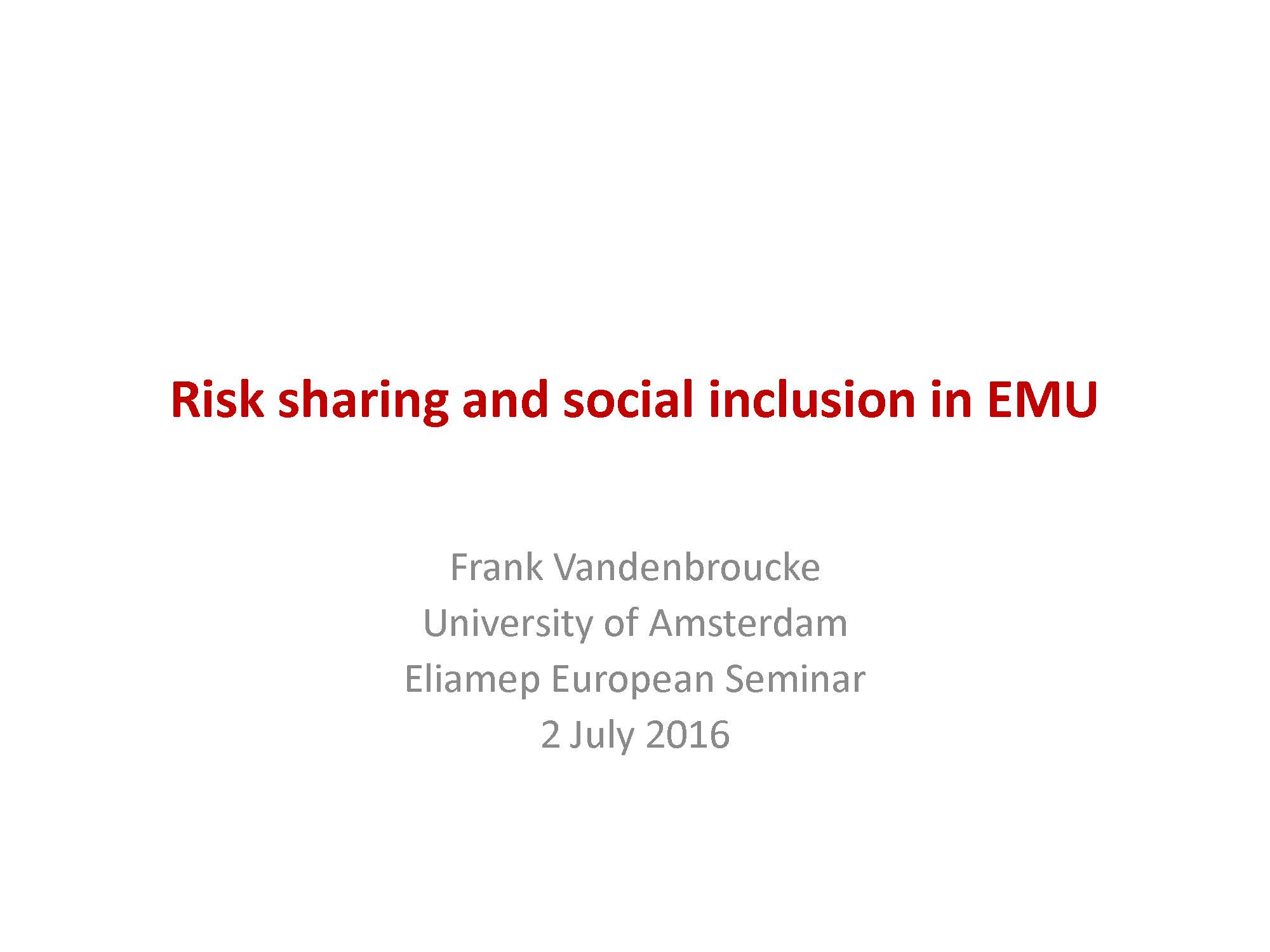 Download presentation
Download presentation
Eliamap_seminar_Vandenbroucke_2.7.2016
Risk sharing and social inclusion in EMU
Frank Vandenbroucke
University of Amsterdam
Eliamep European Seminar
2 July 2016
Social and economic stabilisation: a key function of welfare
states
• ‘Poverty stabilisation’
• Macro-economic stabilisation
‘Poverty stabilisation’: the contribution of transfers (not
pensions) in the reduction of poverty
0
5
10
15
20
25
30
2004-06 2012
Inefficient ‘pension-heavy’ welfare states
Erosion of mature welfare states ?
Source: Eurostat, own calculation of ‘poverty reduction by transfers (excl. pensions)’, total population, SILC
2005-2007 en SILC 2013
Macro-economic stabilisation: smoothing of economic shocks:
US vs. EMU
-10%
0%
10%
20%
30%
40%
50%
60%
70%
80%
US EMU 1979-1998 EMU 1999-2010
Saving
Net taxes and transfers
Factor income and capital
depreciation
Total smoothed
US:
– Federal tax-and-benefit system
– State-based unemployment insurance
with federal framework & extensions
Furceri & Zdzienicka, The Euro Area Crisis…, IMF Working Paper
Defining the EMU’s social objective is a necessity rather than a
luxury
• Any ‘Eurozone re-insurance’ of ‘national stabilisation policies presupposes
(a) minimum requirements w.r.t. the adequacy of national unemployment
insurance and the concomitant labour market regulation; and (b) general
trust in the quality of each other’s social fabric.
• EMU forces upon the member states :
– a shared conception of labour market flexibility
– symmetric guidelines on wage cost competitiveness
& institutions that can deliver
– long term: sustainability of pensions
• The need for conceptual clarity: a European Social Union ≠ a European
Welfare State
A European Social Union
A Social Union would
• support national welfare states on a systemic level in some of their
key functions (e.g. stabilisation)
• guide the substantive development of national welfare states – via
general social standards and objectives, leaving ways and means of
social policy to Member States – on the basis of an operational
definition of ‘the European social model’.
⇒ European countries would cooperate in a union with an explicit
social purpose, pursuing both national and pan-European social
cohesion
A European Pillar of Social Rights: arguments & caveats
• A basic consensus about the general features of the ‘social
order’ that is associated with the Monetary Union is a
necessity; the EPSR can contribute to such a consensus.
• Upward convergence across the EMU/EU28 requires a
combination of social investment, sufficiently egalitarian
background conditions and social protection, as embodied in
the EPSR.
• Caveat: perception of ‘replay’ of earlier soft initiatives will
backlash
Thank you
1) Furceri, D. en A. Zdziencicka, The Euro Area Crisis: Need for a Supranational Fiscal Risk Sharing
Mechanism ?, IMF Working Paper 13/198, 2013
2) Beblavy, M., G. Marconi en I. Maselli, A European Unemployment Benefit Scheme. The rationale and the
challenges ahead, CEPS Special Report No. 119, 2015
3) Vandenbroucke, Sociaal beleid in een muntunie: puzzels, paradoxen en perspectieven, Inaugural
Lecture at the University of Amsterdam, 1 June 2016 www.frankvandenbroucke.uva.nl
4) Vandenbroucke and Rinaldi, Social inequalities in Europe – The challenge of convergence and cohesion. In:
Vision Europe Summit Consortium (eds.): Redesigning European welfare states – Ways forward, Gütersloh
(http://www.vision-europe-summit.eu/)
5) Vandenbroucke, The Case for a European Social Union. From Muddling through to a Sense of Common
Purpose, in Marin, B. (Ed.), The Future of Welfare in a Global Europe, Ashgate: Aldershot UK, 2015, pp.
489-520.
6) Vandenbroucke, A European Social Union: Unduly Idealistic or Inevitable?, European Debates, 7, European
Investment Bank Institute, September 2015 (http://institute.eib.org/wp-content/uploads/2015/09/AEuropean-Social-Union-Unduly-Idealistic-or-Inevitable.pdf)
www.frankvandenbroucke.uva.nl
